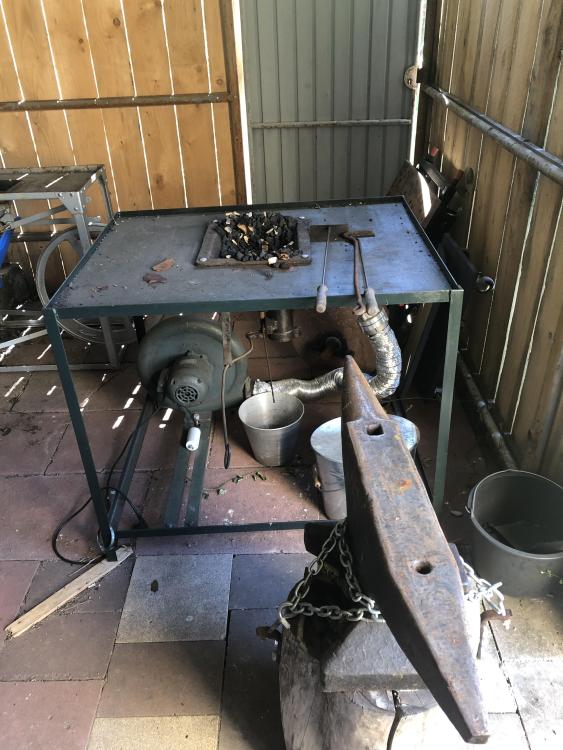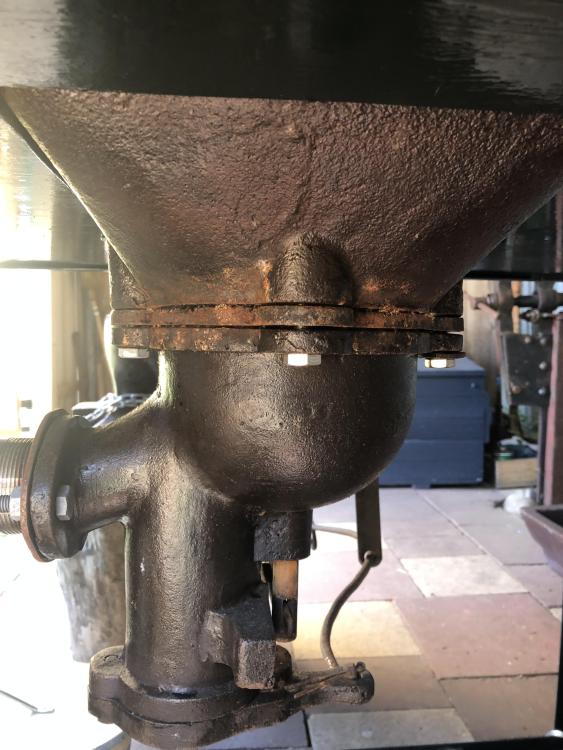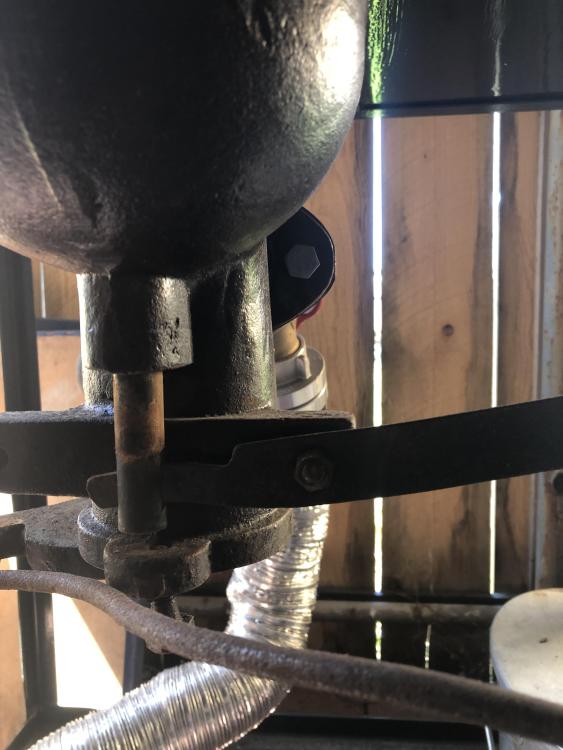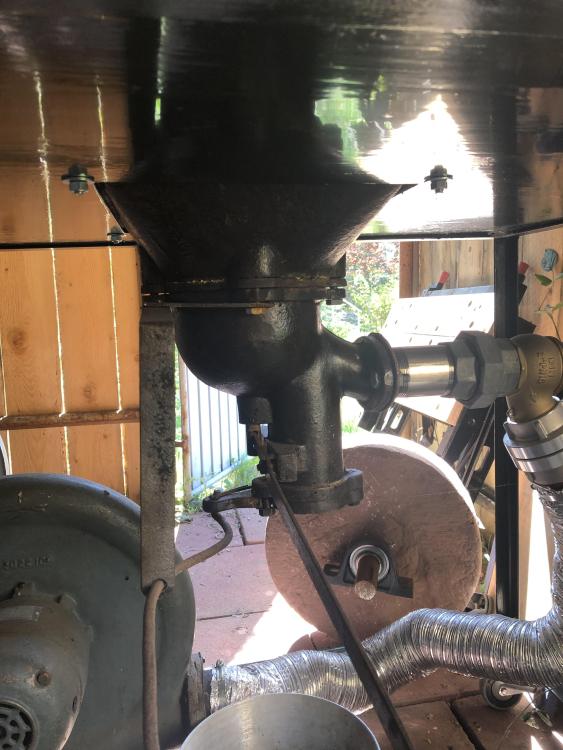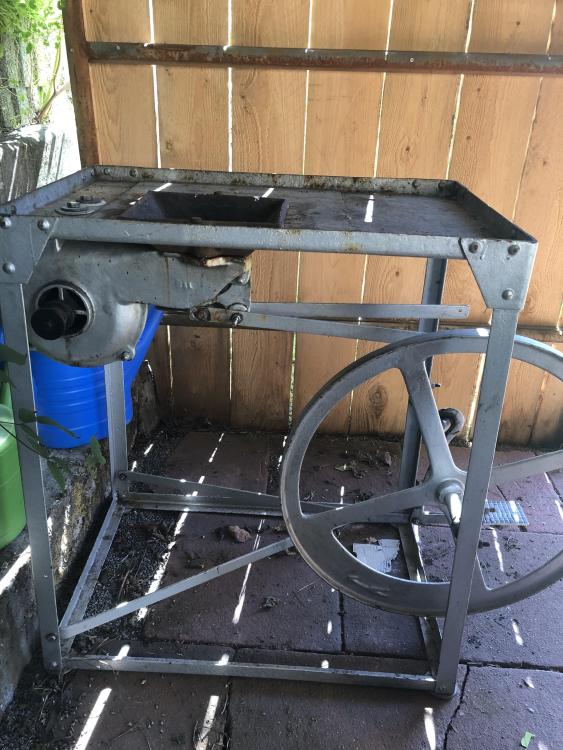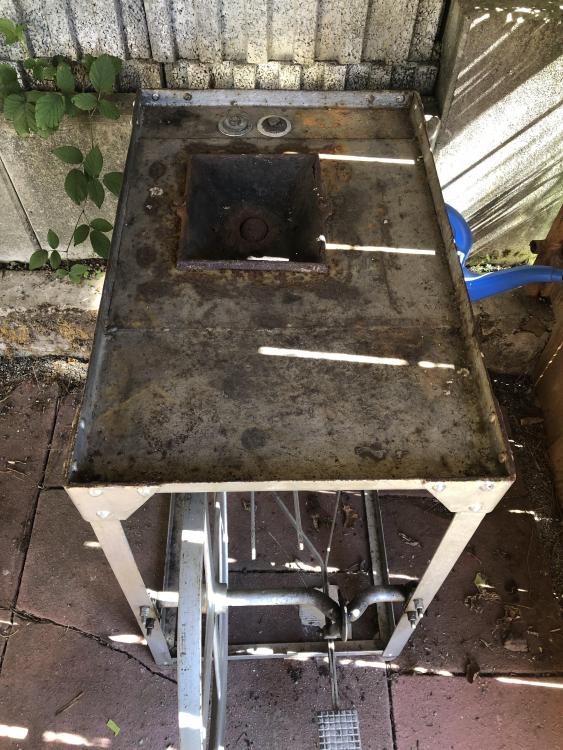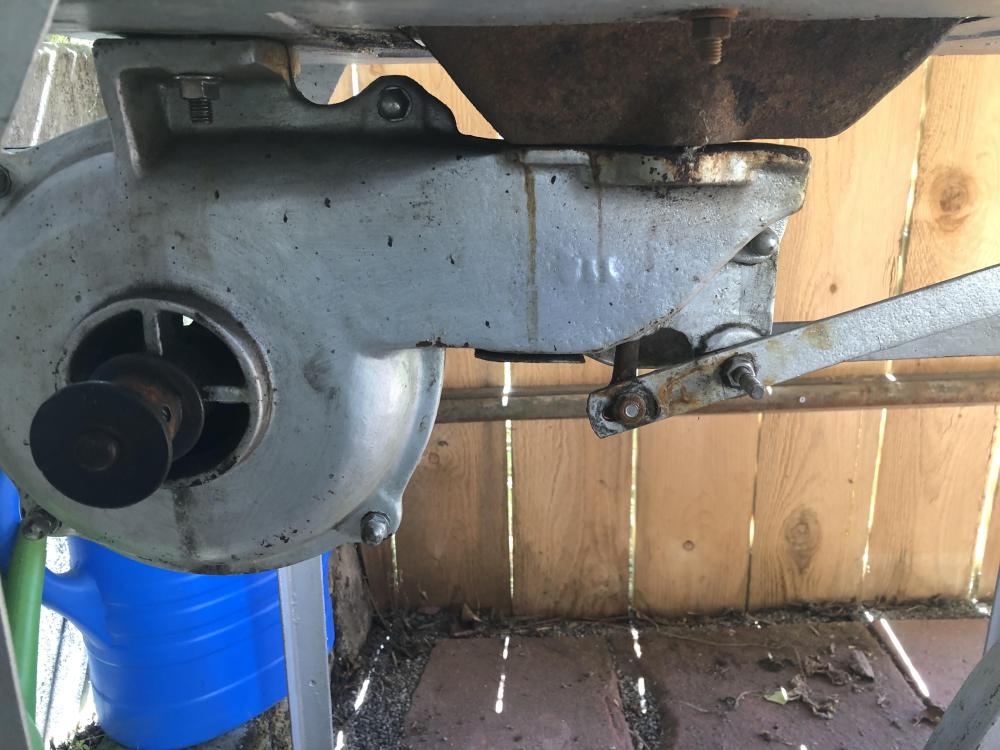
DerFeldschmied
Members-
Posts
11 -
Joined
-
Last visited
Content Type
Profiles
Forums
Articles
Gallery
Downloads
Events
Everything posted by DerFeldschmied
-
Ah, I forgot about putting the pictures of my forges into the reply. Above you can see my main forge which is built like most forges in Germany: Fabricated angle iron table, big cast iron firepot, electric forge blower. On the last three pictures you can see the tuyere construction with a up-down-clinker breaker and a lever-operated slidind ash dump. The three pictures above show the equivalent to a rivet forge called „Feldesse“ which means roughly „field forge“ so a forge which was used in army camps or so. You can see that it has the same, common angle iron construction (this time partly riveted) and also a cast iron firepot. It also has a up-down clinker breaker and a lever operated ash dump and you can see the foot pedal which operates the flywheel which then turns the blower via a flat belt (which is not mounted at the picture). Those forges aren’t that bad at all because you don’t need electricity and have both hands free for holding the workpiece and caring for the fire. Nevertheless, those forges are limiting due to the size of the blower and firepot. I hope those images help understanding my first post. P.S: I apologize for my messy workshop it is still in winter mode and I hope to get it tidy this week! Greetings
-
Hey, thank you for all those responses, I am glad that it seems a bit interesting to the community. The explanation for the lack of cast and manually operated forges that there was already a „blacksmithing infrastructure“ in Europe and that steam power made manual machines needless are really good points I didn’t really thought about before. Another idea that came to my mind was that many old tools were scrapped during both World Wars when they needed a big supply of steel and iron in a short amount of time. At least that’s what I once heard about anvils. Also the destruction of factories could also have caused a loss of old tools while in the US I believe it was much easier to get old tools from metal enterprises running out, I read here in the forum once that Ohio seems to be (or was) an El Dorado for Blacksmithing Supply. I know of a few knife makers and reenactors of course which use some JABOD or Japanese style forges. But I never heard of any regularly produced side blast forge here in Germany. Yes there is! I really can recommend the German Blacksmithing Forum http://v2.schmiededaseisen.de . I used to be pretty active there (same username as here) but since it became very quiet there (some problems with the admin and stuff like that I don’t know the details), I almost completely switched to this community which is far more busy! However, there's still much to see about craft, tools, etc. Of course it is in German (although there’s a small English corner) but with common translators this may be no big issue I believe. Sorry for not having introduced myself yet, although I am active here for half a year now, I seem to have forgotten this. My name is Paul, I am 19 years old and started Blacksmithing back in 2018, sometimes doing more, sometimes less. So I would consider myself still being a beginner and a passionate tool collector (although I don’t know any smith who isn’t). You’re right, sorry for that! But I see you already changed it, thanks! Despite of the German Blacksmithing Forum I believe there are. But due to German Work and Apprenticeship/Profession laws, those guilds are more like Unions and Associations which are more or less integrated into metal industry unions so it’s nothing a hobbyist can join so easily or interact with. But I am not that sure about this, I really didn’t thought about this before, so I may be wrong. Well I have to admit this may be true (at least in Germany). But this is also caused by the fact that there are basically two professions: Firstly there is the normal „Schmied“ so the blacksmith who does all kind of artistic and forged stuff (also tools and knives but not that often). On the other hand, there’s the „Schlosser“ which means locksmith who does all those metalwork for example fenced, doors, locks, steel construction in general. The Schlosser may also sometimes forge decorative elements but mostly he fabricates and machines things. So it may seem that German blacksmiths tend to dislike fabrication and such stuff but I think it’s really based on the fact that it’s not their profession. But much of this traditionalism is also caused by the strict profession and and apprenticeship laws which may cause a longer and stronger tradition. Hobbyists, however seem to be much more flexible in their work. There are, in fact many hand cranked blowers in France, I know of two companies called „Air et Feu“ and „Le Mistral“ but sadly I couldn’t find out much about the companies expect of the name. But those French blowers are also different to the US ones because they are much smaller. I think they are comparable to those Champion and Buffalo put on their Rivet forges. Interestingly, blacksmithing stuff is in comparison to the US very cheap and common. Especially anvils show up very frequently here to moderate prizes (I bought mine, a 220lb South German Pattern in acceptable to good condition for around 250€ So 1-2€ per pound). I think those prizes and frequent offers are an effect of the low demand. However, I noticed that the prizes grew and the quality of offers shrunk within the past years so I'm glad that I have all of the stuff I need. Well, to be honest, I would consider myself traditional concerning my setup. If I would do a living out of blacksmithing, I would think differently but as a hobbyist, I enjoy working with old and special tools and to kind of experience how the craft was back in the days. So all those cast iron or manually operated tools are much more interesting to me than fabricated and electric ones. Also it makes me kind of sad to see all those old yet working machines on the market which are only one step from melting pot so I want to give them a new purpose. Besides, for me personally, old tools are much handier, too. For instance I use a Coal forge and want to use a hand crank blower because I don’t have electricity in my shop and don’t want to roll out a cable every time. Also, electric blowers (or at least mine) are too loud for my neighbors and last but not least, I am a little afraid of gas forges (I know that sounds funny but I stay with good old coal! xD). But besides that, you’re right, I am really interested in old tooling and how those were used and produced in other countries! So, that was a very long answer but I hope I was able to answer some questions. If there are any other questions, feel free to ask! Greetings P.S.: I don’t get rid of the quotation below nor can I move it so I let it stay there. It is meant to stand before the last paragraph.
-
Happy Easter everyone! So since I am currently working out with TWISTEDWILLOW to get my hands on a Champion 400 forge blower(thanks again to you for your help!), I informed myself pretty well about the whole Coal Forge/Forge Blower topic. That being said, I recognized that European (or at least German) coal forges are pretty different to those you find normally in the US and Canada, which I for myself think is really interesting. So I decided to create this thread in case someone is also interested in this topic or if someone needs help eventually identifying his forge. If this topic is in any way annoying or needless because no one cares about German and American Forge Design, then please tell me, I just thought it might be interesting. Anyways, here are the main differences I recognized: I. The forge pan/table. I found out that the main frame construction is pretty different on both continents. While in the US there’s a broad variety of pressed steel, welded sheet metal or cast iron forge pans (which I personally really like), in Germany almost every forge is made out of sheet metal. They are mostly riveted out of angle iron in a simple but stable square construction. The table itself is mostly sheet metal. Sometimes they are also welded. While in the US, the legs are often made out of Pipe or even cast, here they are whether the mentioned angle iron construction or sometimes also pipe. II. The Firepot and Tuyere In the US, there are often those rivet forge style pans, which only contain a grate while firepot is built up out of clay. This concept of lining a forge doesn’t exist in Germany (interestingly, lined forges are common in France but that's something for another thread). Nearly every forge available here has a square cast iron firepot with tuyere similar to the ones champion or buffalo forge produced (yet without the overlap for the clay lining). Another difference is the tuyere. US clinker breakers often just spin on an axle, while the ones here mostly go up and down. Also US ash dumps tend to have a short, weighted lever while many ash dumps here seem to have a long lever. III. Air Supply (Ignoring bellows) That is, at least for me, the most interesting difference. While in the US, lever operated and hand crank blowers (which came to their pinacle with the Champion 400, Buffalo or Canedy-Otto) are very common, there are really none hand crank blowers to find in Germany (In France however, they seem to be also much more common yet much smaller models than in America). Here, forges are almost always equipped with an electric or foot operated blower, which turns a flywheel and further, the fan. However, those foot operated forges are commonly just rivet forges, not stationary ones. So, those are basically the most common differences I was able to recognize between American and European Coal Forge Design. It may also be interesting to mention that I never saw some kind of Rivet Forge in Germany or France. Important note: I don’t want to state those points as sure. I know that there are also varieties and exceptions and if anything I wrote here is incorrect, please correct me. Those differences were only the ones I recognized while watching the different antique markets and by reading in this forum and the german blacksmithing forum. I for myself really like and prefer the American style of forges, especially the cast iron forge pans. Greetings! P.S.: Especially the fact that in Germany there are almost no cast forge pans, as well as no hand crank blowers I find really interesting yet I don’t have any explanation for it. So if anyone has an idea or explanation for this, please share it! P.P.S.: I may add photos of my forges if wanted, if not you can see the common german forge construction at the website of the german forge supplier „Angele Schmiedetechnik“, who sell forges in many different styles.
-
Coal storage.
DerFeldschmied replied to jason0012's topic in Solid Fuels: Coal, Coke, Charcoal, Wood, etc
Don't know if anyone cares but I have another pretty ideal yet not easily accessible method to store coal. Due to my Smithy is a shed in our garden, I store my coal in an old outdoor fireplace by our housewall. It holds around 50 to 75 liters of coal and keeps it pretty dry. If I need some, I simply take a shovel and a bucket and carry the coal the 150 ft to my workshop. And besides a few leaves falling in through the chimney, I couldn't imagine a better coal bunker for my needs. If wanted I can give pictures too. Greetings -
What is the fascination of knivemaking?
DerFeldschmied replied to DerFeldschmied's topic in Knife Making
Well, thank you all a lot for your answers! I think I can now understand a little bit better why forging knives is so popular. Over all, it is a very good thing to the craft, because knivemaking brings more people into the craft who then get more interested in other aspects of blacksmithing and so prevent the craft from obliteration. Greetings -
Hey, I'm a fairly new member since I introduced myself last Saturday but I do have a big question to everyone here already. To get right into it: Why is (or at least seems to me) knivemaking so hyped whereas there are so many and fascinating other branches of smithing (toolmaking, blacksmithing, industrial smithing, armouring, etc.)? I really don’t get the excitement about knivemaking. I for myself forged a few knives and blades and it was an interesting experience to me but nothing I wanted to do mainly. It seems to me that the steps are always the same ones (forging the blade, grinding, making the handle, etc.) and the results are, yet everytime individual, always similar not to mention the lack of use for more than a dozen knives for a regular person. I really don’t want to offend anyone here, if you enjoy knivemaking it is just fine! Whether it is a hobby or a job, it needs to make you happy and if it does, everything is as it should be! But could the knivemakers of you (or any other member) please try to share and explain their fascination and reasons for making knives and blades to me? Greetings
-
This may be a german „Sichelschmidt und Schlasse“ anvil. Also the pattern seems to fit.
-
Hello, thank you all very much for your kind welcome! Actually I am active member of the german blacksmithing forum for three years but it became pretty silent there since last year so I hope and belief to have more commerce and conversation here with all of you! Greetings
-
Hello! After a while of reading many topics here, I finally decided to sign up. My name is Paul I am 18 years old and from Bensheim in southern Hassia in Germany. I was always interested in history and so my passion on old crafts, especially blacksmithing, but also agriculture and old machinery began when I was 14. Since back then, I am forging, yet quite irregular. But I am always interested in old tools and new knowledge about them. I am excited to become part of this community and say hello to each of you! Greetings from Germany
